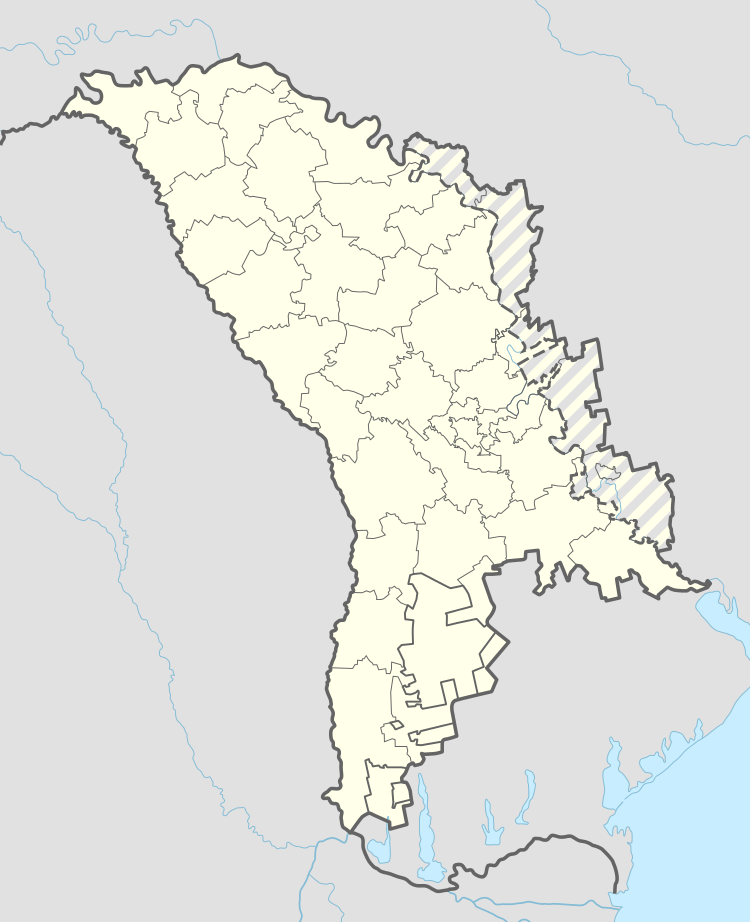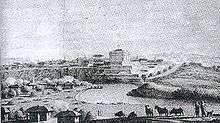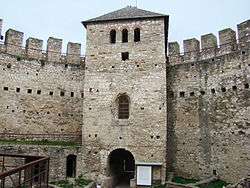Soroca
| Soroca | |
|---|---|
| City | |
|
| |
 Soroca | |
| Coordinates: 48°10′N 28°18′E / 48.167°N 28.300°ECoordinates: 48°10′N 28°18′E / 48.167°N 28.300°E | |
| Country |
|
| County | Soroca |
| Government | |
| • Mayor | Victor Său |
| Elevation | 45 m (148 ft) |
| Population (2012) | |
| • Total | 37,500 |
| Postal code | MD-3001 |
| Area code(s) | +373 230 |
| Website | Primăria Soroca |
Soroca (Russian: Сороки Soroki, Ukrainian: Сороки Soroky, Polish: Soroki, Yiddish: סאָראָקע Soroke) is a Moldovan city in Eastern Europe situated on the Dniester river about 160 km north of Chișinău. It is the administrative center of the Soroca District.
History

The city has its origin in the medieval Genoese trade post of Olchionia, or Alchona. It is known for its well-preserved stronghold, established by the Moldavian prince Stephen the Great (Ştefan cel Mare in Romanian) in 1499.[1] The origins of the name Soroca are not fully known. Its location is only a few kilometers from the Moldova-Ukrainian border.
The original wooden fort, which defended a fjord over Dniester, was an important link in the chain of fortifications which comprised four forts (e.g. Bilhorod-Dnistrovskyi, then known as Akkerman, and Khotyn) on the Dniester, two forts on the Danube and three forts on the north border of medieval Moldova. Between 1543 and 1546 under the rule of Peter IV Rareș, the fort was rebuilt in stone as a perfect circle with five bastions situated at equal distances.
During the Great Turkish War, John III Sobieski's forces successfully defended the fort against the Ottomans. It was of vital military importance during the Pruth River Campaign of Peter the Great in 1711. The stronghold was sacked by the Russians in the Austro-Russian–Turkish War (1735–39). The Soroca Fort is an important attraction in Soroca, having preserved cultures and kept the old Soroca in the present day.
The locality was greatly extended in the 19th century, during a period of relative prosperity. Soroca became a regional center featuring large squares, modernized streets, hospitals, grammar schools and conventionalized churches. In the Soviet period, the city became an important industrial center for northern Moldova.[2]
Soroca was known for producing grapes, wheat, maize, and tobacco in 1919.[1]
Climate
The climate in Soroca is a warm-summer subtype (Köppen: Dfb) of the humid continental climate.
| Climate data for Soroca | |||||||||||||
|---|---|---|---|---|---|---|---|---|---|---|---|---|---|
| Month | Jan | Feb | Mar | Apr | May | Jun | Jul | Aug | Sep | Oct | Nov | Dec | Year |
| Daily mean °C (°F) | −4.7 (23.5) |
−3.2 (26.2) |
1.5 (34.7) |
9.2 (48.6) |
15.0 (59) |
18.1 (64.6) |
19.5 (67.1) |
18.9 (66) |
14.8 (58.6) |
9.0 (48.2) |
3.0 (37.4) |
−1.7 (28.9) |
8.28 (46.9) |
| Average precipitation mm (inches) | 35 (1.38) |
36 (1.42) |
31 (1.22) |
49 (1.93) |
65 (2.56) |
93 (3.66) |
90 (3.54) |
58 (2.28) |
48 (1.89) |
31 (1.22) |
38 (1.5) |
39 (1.54) |
613 (24.14) |
| Source: Climate-Data.org[3] | |||||||||||||
Demographics
The population was estimated at 35,000 in 1919. It consisted mainly of Jews. Romanians, Germans and Russians also lived in the city.[1] The city once had a Jewish population of around 18,000 but they are only 100 today and 20 of them are considered Jewish according to the halakha.[4]
In 2012, Soroca had an estimated 37,500 inhabitants.
The city has a sizable Romani (Gypsy) minority and is popularly known as the "Romani capital of Moldova."[5]
Natives
| Historical population | ||
|---|---|---|
| Year | Pop. | ±% |
| 1897 | 15,351 | — |
| 1919 | 35,000 | +128.0% |
| 1930 | 14,661 | −58.1% |
| 1959 | 14,895 | +1.6% |
| 1970 | 24,465 | +64.2% |
| 1979 | 31,831 | +30.1% |
| 1989 | 42,297 | +32.9% |
| 2004 | 28,362 | −32.9% |
| 2012 | 37,500 | +32.2% |
| Source: [6][7] | ||
- Samuel Bronfman (1889–1971), a Canadian entrepreneur, former owner of Seagram
- Alexandru Cimbriciuc
- Arkady Gendler - Yiddish Singer
- Sofia Imber, a Venezuelan journalist, founder of the Contemporary Art Museum of Caracas
- Kira Muratova, a Soviet and Ukrainian film director, screenwriter and actress
- Nicolae Soltuz, a member of Sfatul Ţării
- Robert Steinberg, a Canadian mathematician
- Leonte Tismăneanu, a Romanian communist activist
- Eugen Ţapu (1983–2009), a protestor in the post-election riots in Chișinău who died while in police custody
- Gheorghe Ursu (1926–1985), a Romanian construction engineer
Media
- Observatorul de Nord, a newspaper from Soroca, founded in 1998[8][9]
- Vocea Basarabiei, 67,69 and 103.1
Gallery




.jpg) Soroca 1898 local stamp
Soroca 1898 local stamp
International relations
Twin towns – Sister cities
Soroca is twinned with:
|
See also
- Romanian architecture
- History of the Jews in Bessarabia
- Romani people in Romania
- Armenians in Moldova
References
| Wikimedia Commons has media related to Soroca. |
| Wikivoyage has a travel guide for Soroca. |
- 1 2 3 Kaba, John (1919). Politico-economic Review of Basarabia. United States: American Relief Administration. pp. 13–14.
- ↑ Tourist towns of Moldova
- ↑ "Climate in Soroca". Climate-Data.org. Retrieved 9 April 2014.
- ↑ "Moldovan Jews struggle to maintain their historic community amid poverty, anti-Semitism". Jewish Telegraphic Agency. 20 June 2012. Retrieved 9 January 2014.
- ↑ Steve Kokker, Cathryn Kemp (2004) "Romania and Moldova" (a travel guide), ISBN 1-74104-149-X p.322
- ↑ Demoscope Weekly - Annex. Statistical indicators reference
- ↑ Moldova: Districts, Major Cities & Towns - Statistics & Maps on City Population
- ↑ Radio Free Europe/Radio Liberty, „Nici tu ploaie ca lumea, nici tu limpezirea apelor în domeniul politicii”
- ↑ Reporter european
